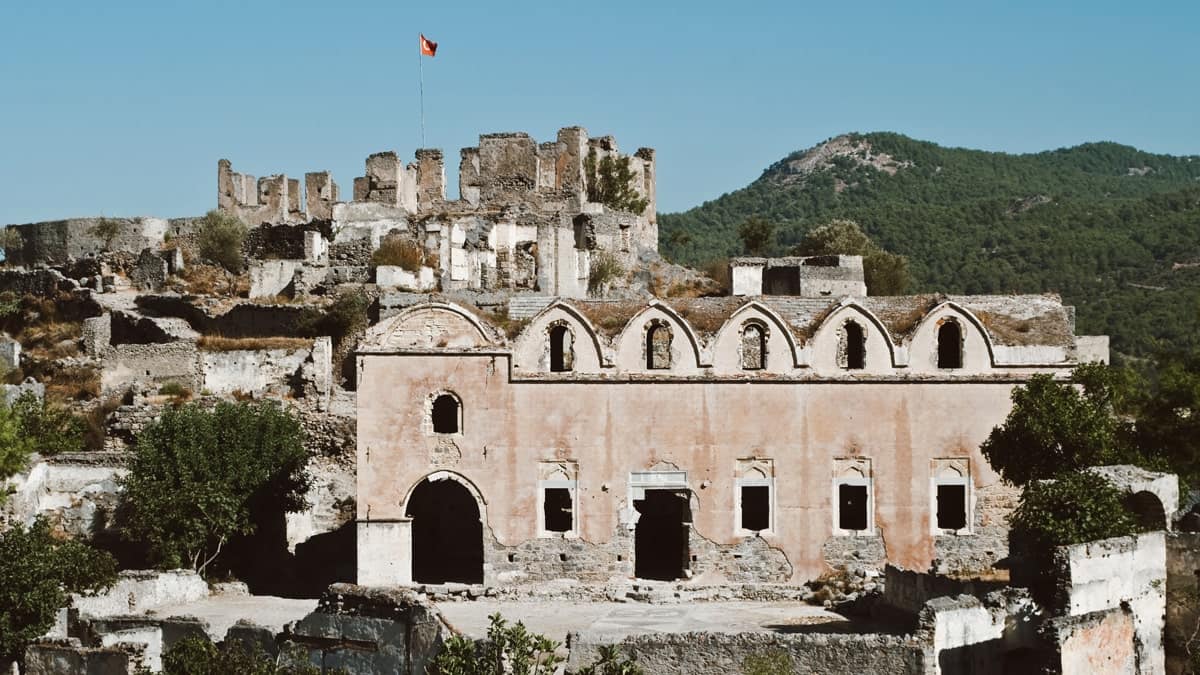Imagine a valley in Fethiye’s backyard, surrounded by pine forests, where even the wind blows gently. There, lies Kayaköy, where time seems to stand still, stone houses nestled against one another, and churches now speak only to the wind. Although today known as a “ghost village,” this description fails to describe its deep, lived-in past. Kayaköy’s abandoned Greek houses are more than just stone and mortar. They bear the traces of a nation being uprooted from its homeland, a culture being silenced.
From Levissi to Kayaköy: The Identity Transformation of a Village with Two Names
Kayaköy, as it is known today, was known as Levissi during the Ottoman period. From the 18th century onward, the largely Greek Orthodox population lived here peacefully, building stone houses, growing olives, producing wine, and sending their children to school. Side by side with Muslim Turkish villages, they established common markets and celebrated holidays together. However, the collapse of the Ottoman Empire in the early 20th century, the Balkan Wars, and the dark period following World War I brought an end to this practice of coexistence.
The forced population exchange under the Treaty of Lausanne in 1923 changed Kayaköy’s fate forever. Greeks were deported to Greece, and the Muslim immigrants who replaced them chose not to live in these stone-built houses with their distinctive architecture. Some settled on the village’s periphery, while others chose flatter, more arable land. Thus, although Kayaköy may appear to be a pile of abandoned stones, it has become a monument of silence, enshrining the memory of centuries.
A Novel Written in Architecture: The Structure of Kayaköy Houses
The first thing one notices when exploring Kayaköy is the meticulous planning and aesthetically pleasing construction of the houses. Approximately 500 buildings are arranged on the hillsides using a terracing technique. This layout ensures that every house remains open, receives light, and offers a panoramic view. This detail alone demonstrates the advanced architectural and social understanding of the people of Kayaköy.
Most of the houses are two-story. The ground floor was generally used as a pantry, storage, and kitchen, while the upper floor served as living space. The wood used in the ceilings, the stonework on the walls, and the placement of the stoves convey not only functionality but also aesthetic elegance. Even the orientation of the windows and doors was determined with consideration for air circulation and natural light. Kayaköy houses were designed not simply as residences in the past, but as a reflection of craftsmanship, taste, and harmony with nature.
Faith, Education, and Society: Churches, Schools, and Social Buildings
Kayaköy is more than just houses. The village boasts two large churches and several smaller chapels. The largest of these, Taksiyarhis Church, is the heart of Kayaköy. This structure, which still stands today, features frescoes, arched windows, and stone carvings that have stood the test of time. Although the bells no longer ring, the church continues to silently carry the traces of its past.
In addition to the church, the village is known to have a primary school, a girls’ school, a library, and even a health center. These structures demonstrate that Kayaköy was a developed settlement not only architecturally but also socially. The people lived a life intertwined with art, education, faith, and nature.
A Journey to the Depths of the Soul: What Do You Feel When You Stroll Kayaköy?
Walking in Kayaköy isn’t just about visiting a historical site. Every step, every ruined wall, every windowless house holds a memory, a whisper, a sigh. In the empty rooms, you hear echoes of the past. Perhaps you’re passing by a room where a mother sang a lullaby to her child. Perhaps that ruined stone structure is a workshop where a carpenter worked…
Most tourist guides describe this place as a “ghost village.” Yet, Kayaköy isn’t a ghost; it’s a village with a soul, one that speaks to its past. Here, the past still breathes. If you close your eyes, perhaps an old wedding procession passes through your memory; perhaps children’s laughter hits the stones and returns to you.
A Silence Protected: What is the Status of Kayaköy Today?
Kayaköy is an important cultural heritage site for both Turkey and the world. Declared a village of peace and friendship by UNESCO, this area is under protection. Some buildings have been restored, and a few houses have been converted into artistic workshops or boutique guesthouses. However, the overall structure has remained untouched. This natural, untouched state is the essence of Kayaköy’s charm.
Today, Kayaköy is a source of inspiration for artists, historians, and photographers. It has also hosted the filming of numerous international films and documentaries. Its natural beauty, connection to the past, and deep atmosphere captivate visitors.
How to Get to Kayaköy? Transportation Information
Located approximately 8 kilometers from the center of Fethiye, Kayaköy is highly accessible for both individual travelers and group tours. This historic village, easily accessible from Fethiye and its surrounding area, can be visited by both road and hiking trails.
Transportation from Fethiye Center to Kayaköy
Reaching Kayaköy is quite easy using minibuses (dolmuş) departing from Fethiye center. With frequent services, especially during the summer months, you can reach the village in a short 20-minute journey. Minibuses generally depart from the dolmuş stops right next to the Fethiye Bus Station. You’ll see signs reading “Kaya Köyü” or “Hisarönü – Kayaköy” on the vehicles.
A delightful landscape of pine forests, olive groves, and typical Aegean architecture awaits you along the way. The road is paved and in excellent condition.
